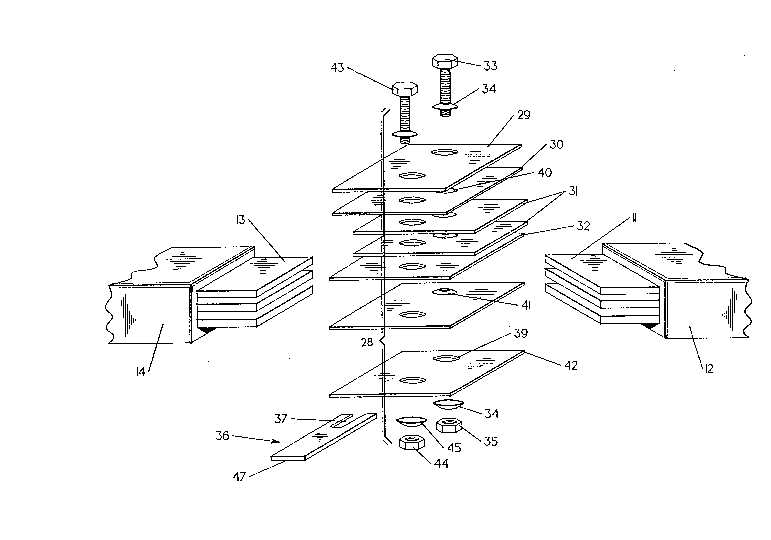Une partie des informations de ce site Web a été fournie par des sources externes. Le gouvernement du Canada n'assume aucune responsabilité concernant la précision, l'actualité ou la fiabilité des informations fournies par les sources externes. Les utilisateurs qui désirent employer cette information devraient consulter directement la source des informations. Le contenu fourni par les sources externes n'est pas assujetti aux exigences sur les langues officielles, la protection des renseignements personnels et l'accessibilité.
L'apparition de différences dans le texte et l'image des Revendications et de l'Abrégé dépend du moment auquel le document est publié. Les textes des Revendications et de l'Abrégé sont affichés :
| (12) Demande de brevet: | (11) CA 2087764 |
|---|---|
| (54) Titre français: | JOINT DE CONTACT REGLABLE POUR BARRE BLINDEE ELECTRIQUE |
| (54) Titre anglais: | ELECTRIC POWER BUSWAY ADJUSTABLE POWER TAKE-OFF-JOINT |
| Statut: | Réputée abandonnée et au-delà du délai pour le rétablissement - en attente de la réponse à l’avis de communication rejetée |
| (51) Classification internationale des brevets (CIB): |
|
|---|---|
| (72) Inventeurs : |
|
| (73) Titulaires : |
|
| (71) Demandeurs : |
|
| (74) Agent: | CRAIG WILSON AND COMPANY |
| (74) Co-agent: | |
| (45) Délivré: | |
| (22) Date de dépôt: | 1993-01-21 |
| (41) Mise à la disponibilité du public: | 1993-08-11 |
| Licence disponible: | S.O. |
| Cédé au domaine public: | S.O. |
| (25) Langue des documents déposés: | Anglais |
| Traité de coopération en matière de brevets (PCT): | Non |
|---|
| (30) Données de priorité de la demande: | ||||||
|---|---|---|---|---|---|---|
|
41PR-6822
ELECTRIC POWER BUSWAY ADJUSTABLE
POWER TAKE-OFF-JOINT
ABSTRACT OF THE DISCLOSURE
An electric power busway joint includes a plurality of metal
electrically conductive splice plates and electrically
insulative separator plates interleaved to receive the ends of
adjoining electrical busway power conductors. The busway joint
is defined by a pair of apertured side plates which receive an
elongated bolt electrically connecting the ends of the busway
conductors with the conductive splice plates by means of
spring-loaded Belville washers. A plurality of busway stabs
having elongated slots formed within one end are electrically
interconnected with the busway conductors by means of the
conductive splice plates and a separate elongated bolt. The
elongated slots allow the ends of the busway stabs to be ad-
justed accordingly while maintaining the integrity of the
electrical connection between the busbar connectors.
Note : Les revendications sont présentées dans la langue officielle dans laquelle elles ont été soumises.
Note : Les descriptions sont présentées dans la langue officielle dans laquelle elles ont été soumises.

2024-08-01 : Dans le cadre de la transition vers les Brevets de nouvelle génération (BNG), la base de données sur les brevets canadiens (BDBC) contient désormais un Historique d'événement plus détaillé, qui reproduit le Journal des événements de notre nouvelle solution interne.
Veuillez noter que les événements débutant par « Inactive : » se réfèrent à des événements qui ne sont plus utilisés dans notre nouvelle solution interne.
Pour une meilleure compréhension de l'état de la demande ou brevet qui figure sur cette page, la rubrique Mise en garde , et les descriptions de Brevet , Historique d'événement , Taxes périodiques et Historique des paiements devraient être consultées.
| Description | Date |
|---|---|
| Inactive : CIB de MCD | 2006-03-11 |
| Le délai pour l'annulation est expiré | 2001-01-22 |
| Demande non rétablie avant l'échéance | 2001-01-22 |
| Réputée abandonnée - omission de répondre à un avis sur les taxes pour le maintien en état | 2000-01-21 |
| Inactive : Abandon.-RE+surtaxe impayées-Corr envoyée | 2000-01-21 |
| Demande publiée (accessible au public) | 1993-08-11 |
| Date d'abandonnement | Raison | Date de rétablissement |
|---|---|---|
| 2000-01-21 |
Le dernier paiement a été reçu le 1998-12-30
Avis : Si le paiement en totalité n'a pas été reçu au plus tard à la date indiquée, une taxe supplémentaire peut être imposée, soit une des taxes suivantes :
Veuillez vous référer à la page web des taxes sur les brevets de l'OPIC pour voir tous les montants actuels des taxes.
| Type de taxes | Anniversaire | Échéance | Date payée |
|---|---|---|---|
| TM (demande, 5e anniv.) - générale | 05 | 1998-01-21 | 1997-12-18 |
| TM (demande, 6e anniv.) - générale | 06 | 1999-01-21 | 1998-12-30 |
Les titulaires actuels et antérieures au dossier sont affichés en ordre alphabétique.
| Titulaires actuels au dossier |
|---|
| GENERAL ELECTRIC COMPANY |
| Titulaires antérieures au dossier |
|---|
| CLARENCE WILSON WALKER |
| DAVID ALAN HIBBERT |
| JOHN DAVIS ANDERSON |
| LYNN MACON HARTON |